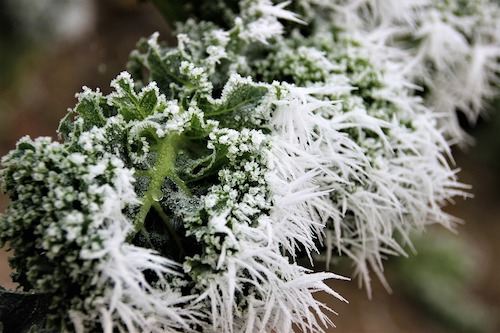Fall gardens are generally touted as being a great way to get another harvest out of a small garden. They’re great for a few other reasons too. Fall is a wonderful time to work in the garden as the heat and humidity lessens. There’s also generally less pest pressure in the fall, meaning you might still get to put up some sauerkraut even if cabbage moths attacked your spring cabbage crop. A lesser discussed benefit is that some fall crops actually become sweeter after a frost.
Why are plants sweeter after a frost?
Unlike animals, vegetables can’t move south for winter, find a cozy den, or grow and extra thick coat. To survive the cold, certain plants have evolved a way to cope with colder temperatures. First, the plants’ cell walls thicken. These thicker walls contain less moisture and freeze less easily. The other part of this process, is the one that we as gardeners relish, the plants convert more of their starches to sugar. This has several benefits. Using the sugar produces energy, in effect, keeping the plant warmer. The sugar also decreases the formation of ice in the cell and prevents the cell membrane from freezing. This process is good for the plant and tasty for the gardener!
What plants do this?
Brassicas (Cabbage Family)
- Cabbage
- Kale
- Brussels Sprouts
- Kohlrabi
- Collards
These plants thrive in cool temperatures making them ideal for fall planting. They can withstand temperatures down to 20°F and some like burssels sprouts can withstand much colder (down to 0°F). Row cover can be used to extend the season further and protect crops from damaging cold winds.
Carrots & Beets
Both beets and carrots benefit from a layer of mulch around their tops in cold weather. In southern climates, these roots can be left in the ground over winter and harvested as needed. To protect the tops for eating beet greens or to keep them growing you may need to use row cover or a cold frame to protect them during consistently cold temperatures.
Turnips & Rutabagas
Turnips and rutabagas are vastly sweetened by cold temperatures. Rutabagas should be harvested before temperatures drop to 20°F but turnips can handle colder temperatures particularly if they’ve been covered in a thick layer of mulch.
In many areas, leeks can be overwintered and survive temperatures down to 10°F. If you’re harvesting leeks from frozen ground our friend Pam Dawling recommends pouring boiling water on the base of the plants if you’re harvesting a few for immediate use.
Swiss Chard
Swiss chard is fairly cold-hardy but it does best with some protection particularly if you live in an area with strong winds. To prolong your chard harvest use row cover or a cold frame. We’ve found Ruby Red Swiss Chard to be more frost tolerant than other varieties.
After a long summer it can be difficult to find the time and motivation to sow a fall garden. It really is worth it though! Plant a few of these crops for a sweet fall harvest.

